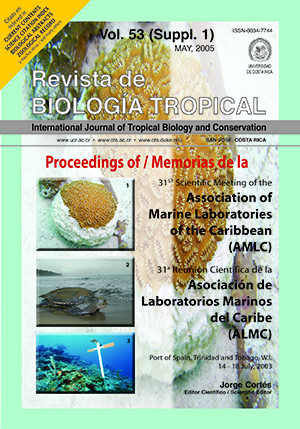Resumen
La distribución espacial de comunidades de pastos marinos y algas puede ser difícil de determinar en sistema lagunares grandes y someros donde la alta turbidez no permite el uso de métodos ópticos, como fotografías aéreas e imágenes satelitales. Complicaciones adicionales pueden surgir cuando las algas no están adheridas permanentemente al sustrato y derivan con las mareas y corrientes. Se realizó un estudio utilizando discriminación acústica del fondo marino en el Indian River Lagoon (Florida, EUA) para determinar la cantidad de algas y pastos que derivan. Se realizaron sondeos acústicos en el Sebastian Inlet con el sistema QTC View V y transductores de 50 y 200 kHz. Las áreas de pastos marinos pudieron ser identificadas, y están mezcladas con una gran cantidad de algas a la deriva. Se rellenó los espacios sin datos con extrapolaciones basadas en la técnica del “vecino más cercano”, produciendo un mapa espacialmente coherente. Comprobaciones de campo con video y “matrices de confusión” indican que los mapas tienen un alto nivel de concordancia (60%) con la distribución real de las algas; sin embargo, hubo cierta confusión entre arena y algas, y entre arena y pastos marinos.Citas
Anonymous. 2000. QTC Impact User Manual. Quester Tangent Corporation, Canada. 110 p.
Bates, C.R. & E.J. Whitehead. 2001. Echoplus measurements in Hopavagen Bay, Norway. Sea Technol. 42: 34-43.
Chivers, R.C., N. Emerson & D.R. Burns. 1990. New acoustic processing for underway surveying. Hydrographic J. 56: 9-19.
Collins, W.T. & P. Lacroix. 1997. Operational philosophy of acoustic waveform data processing for seabed classification. COSU 97, Oceanology International, Singapore 97: 225-234.
Collins, W.T., R. Gregory & J. Anderson. 1996. A digital approach to seabed classification. Sea Technol. 37: 83-87.
Green, E.P., P.J. Mumby, A.J. Edwards & C.D. Clark. 2000. Remote sensing handbook for tropical coastal management. Coastal Management Sourcebooks 3, UNESCO Paris. 316 p.
Hamilton, L.J. 2001. Acoustic seabed classification systems. Department of Defence, Defence Science and Technology Organization (Australia). 150 p.
Hamilton, L.J., P.J. Mulhearn & R. Poeckert. 1999. Comparison of RoxAnn and QTC-View acoustic bottom classification system performance for the Cairns area, Great Barrier Reef, Australia. Cont. Shelf Res. 19: 1577-1597.
Lawrence, M.J. & C.R. Bates. 2001. Acoustic ground discrimination techniques for submerged archaeological site investigations. MTS Journal 35: 65-73.
Legendre, P. 2002. Acoustic seabed classification methodology: a user’s statistical comparison. Departement de Sciences Biologiques, Universite de Montreal. 17 p.
Legendre, P., K.E. Ellingsen, E. Bjornbom & P. Casgrain. 2002. Acoustic seabed classification: improved statistical methods. Can. J. Fish. Aquat. Sci. 59: 1085-1089.
Morris, L.J. & L.M. Hall. 2001. Estimating drift algae abundance in the Indian River Lagoon, FL. St. Johns River Water Management District Tech. Memo. 10 p.
Morris, L.J., R.W. Virnstein, J.D. Miller & L.M. Hall. 2000. Monitoring changes in Indian River Lagoon, Florida, using fixed transects, p. 167-176. In S.A. Bortone (ed.). Seagrass Monitoring, Ecology, Physiology and Management. CRC Press, Boca Raton.
Morrison, M.A., S.F. Thrush & R. Budd. 2001. Detection of acoustic class boundaries in soft sediment systems using the seafloor acoustic discrimination system QTC VIEW. J. Sea Res. 46: 233-243.
Mumby, P.J. & E.P. Green. 2000. Field survey: building the link between image and reality, p. 57-67. In E.P. Green, P.J. Mumby, A.J. Edwards & C.D. Clark (eds.). Remote Sensing Handbook for Tropical Coastal Management. Coastal Management Sourcebooks 3, UNESCO, Paris.
Prager, B.T., D.A. Caughey & R.H. Poeckert. 1995. Bottom classification: operational results from QTC View. Oceans ’95, San Diego, October 1995. Pp. 1827-1835.
Preston, J.M., A. Rosenberger & W.T. Collins. 2000. Bottom classification in very shallow water. Proc. Oceans 2000, Newport. Pp. 1563-1567.
Preston, J.M., W.T. Collins, D.C. Mosher, R.H. Poeckert & R.H. Kuwahara. 1999. The strength of correlations between geotechnical variables and acoustic classifications. Proc. MTS/IEEE OCEANS’99 Conf., September 1999. Pp. 1123-1128.
Preston, J.M., A. Rosenberger, & W.T. Collins. 2000. Bottom classification in very shallow water. Proc. Oceans 2000, Newport:
Preston, J.M., A.C. Christney, L.S. Beran, W.T. Collins & R.A. McConnaughey. 2002. Objective measures of acoustic diversity for benthic habitat characterization. Symp. Effects Fisheries Benthic Habitats: Linking Geology, Biology, Socioeconomy and Management, Tampa 2002. Pp. 45.
Virnstein, R.W. & P.A. Carbonara. 1985. Seasonal abundance and distribution of drift algae and seagrass in the mid-Indian River Lagoon, FL. Aquat. Bot. 23: 67-82.
Virnstein, R.W. & R.K. Howard. 1987. Motile epifauna of marine macrophytes in the Indian River Lagoon, Florida. II. Comparison between drift macroalgae and three species of seagrass. Bull. Mar. Sci. 41: 13-26.
Comentarios

Esta obra está bajo una licencia internacional Creative Commons Atribución 4.0.
Derechos de autor 2005 Revista de Biología Tropical






